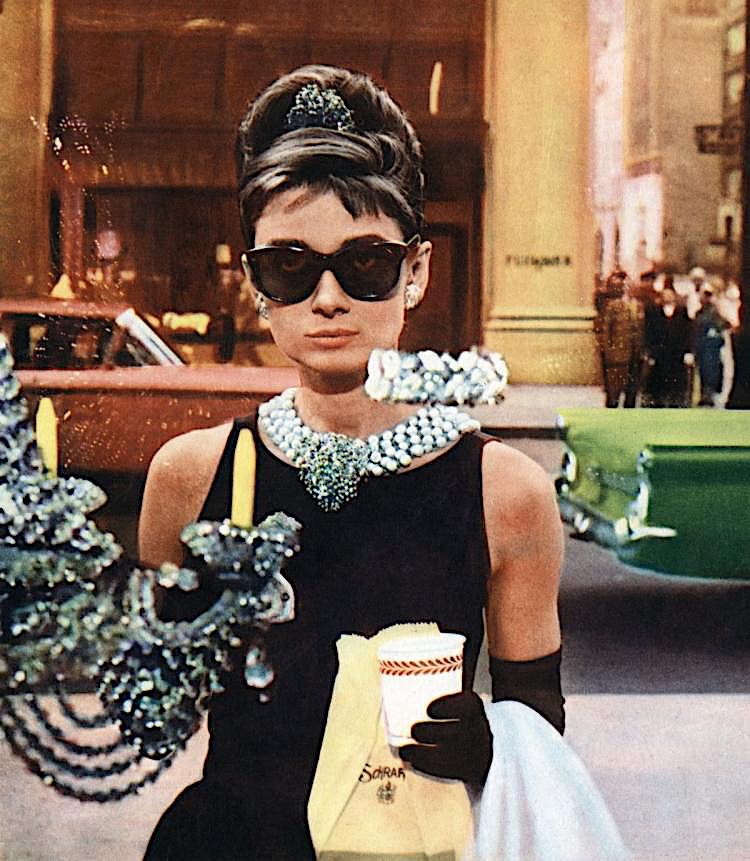MARIANI’S
Virtual Gourmet
May 9, 2021
NEWSLETTER
❖❖❖
IN THIS ISSUE
THE HORROR OF TRYING TO FIT IN
By John Mariani
NEW YORK CORNER
DANIEL HUMM GOES FULL VEGAN
AT ELEVEN MADISON PARK
By John Mariani
CAPONE'S GOLD
CHAPTER SIX
By John Mariani
NOTES FROM THE WINE CELLAR
BRUNELLO DI MONTALCINO IN FLUX
The 2016 Vintage
By John Mariani
❖❖❖


Also: On May 12 on the TV Show Celebrating Act2 I'll
be speaking about the origins and
evolution of Irish food and drink
in Ireland the US.
By John Mariani
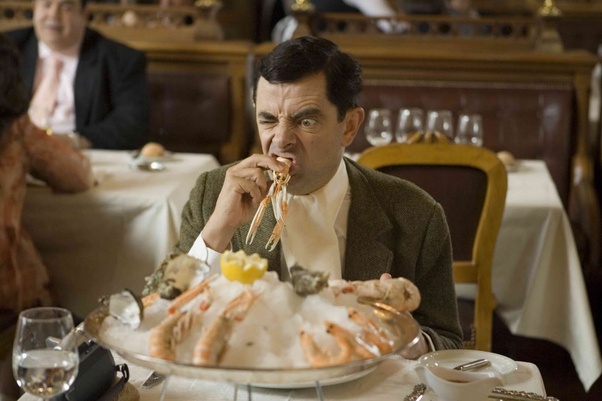
Most
people would not want to go to a restaurant
where he or she would not feel comfortable,
which ranges from places that are way too loud
to those where an attitude of snobbism reigns.
Yet many people do. The loud restaurants are now
legion, usually by design, so as to give the
evening a sense of excitement and razzle dazzle.
Indeed, some chef-owners deliberately want
the piped-in music to blast the glassware off
the table. Many such places may well have good
food, but so often they are simply more a
restaurant-of-the-moment that the media have
declared “hot.” The food hardly matters to the
crowd, mostly on the young side, who care more
about seeing and being seen.
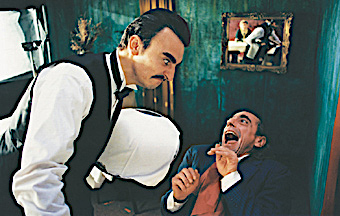 This
applies just as readily to the extreme opposite: a
restaurant where the restaurateur believes you
should feel privileged to dine at his or her
establishment and passes that information off to a
staff paid to act more like gatekeepers than
captains and waiters. Fortunately, even before
Covid, this kind of behavior had pretty much faded
away, even at those temples of French haute
cuisine where there really was a Siberia, as well
as places like ‘21’ Club (now closed), whose
doorman was once quoted about newcomers, “Why
should I be nice to these people, when I don’t
know them?” Most of those places are now gone.
This
applies just as readily to the extreme opposite: a
restaurant where the restaurateur believes you
should feel privileged to dine at his or her
establishment and passes that information off to a
staff paid to act more like gatekeepers than
captains and waiters. Fortunately, even before
Covid, this kind of behavior had pretty much faded
away, even at those temples of French haute
cuisine where there really was a Siberia, as well
as places like ‘21’ Club (now closed), whose
doorman was once quoted about newcomers, “Why
should I be nice to these people, when I don’t
know them?” Most of those places are now gone.
Today, rare is the snooty maître d’ who
puts you in your place rather than your seat; long
gone are the Louis XV trappings that were dated
the day they went up; and though it still goes on,
bribing the head waiter for a “good table” is the
surest way to get you marked as a patsy.
Still,
many people are intimidated at the thought of
going to a truly fine dining restaurant in fear
that they may be made to feel ill at ease and
discomfited. Such people ignorantly contend that
“nobody wants to eat at those places anymore,”
when in fact, both pre-Covid and after, those
dining rooms are always packed. Indeed,
the chances of getting a snub are higher at an
expensive steakhouse with a big expense account
clientele than at a stunning French or Italian
restaurant that may only serve 100 people each
night.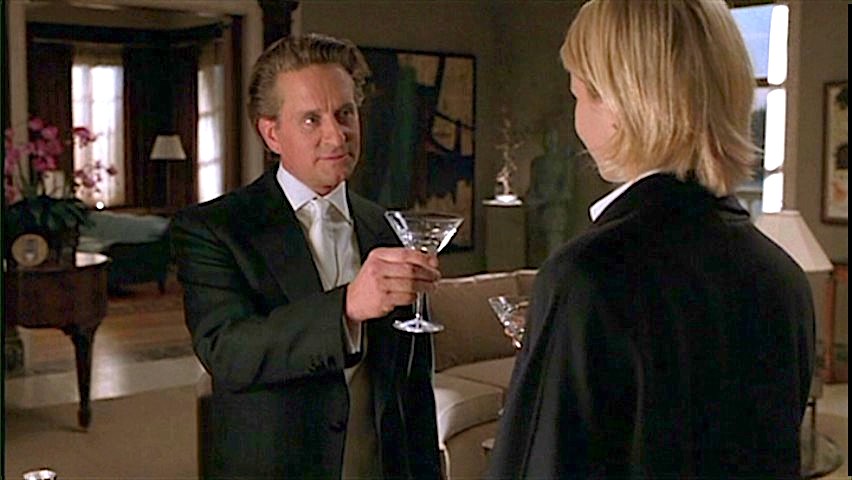
There
will always be those people who, simply, feel ill
at ease dining “fancy.” Correction: Americans
who feel intimidated by posh décor and menus with
unfamiliar fare. French men and women may prefer
their local bistro or Italians their neighborhood
trattoria, but will not feel out of place in a
high-end dining room. The reason is simple: They
were raised with basic ideas of manners, dress and
taste, whereas many Americans are not. The days of
required, even requested, jackets and ties for men
are, sadly, gone, because so many men bristle at
the thought of buttoning their shirt or throwing
on a jacket. Unfortunately, this translates into
showing up at a high-end restaurant wearing jeans,
t-shirt and sneakers on the moronic rationale that
“clothes don’t make the food taste better,” which
is like saying that wearing shorts and a tank top
to a funeral doesn’t make the honoree any less
dead.
These same men also seem obtuse to women’s
appreciation of men in a suit and tie, especially
since most women tend to dress up to go out to
dinner. It’s more an insult to these women than it
is to the restaurant. Put another way, who doesn’t
like to see a man appropriately well dressed?
Wearing a t-shirt and shorts to a pizzeria or crab
shack is perfectly appropriate; wearing the same
at an upscale restaurant of any kind is not.
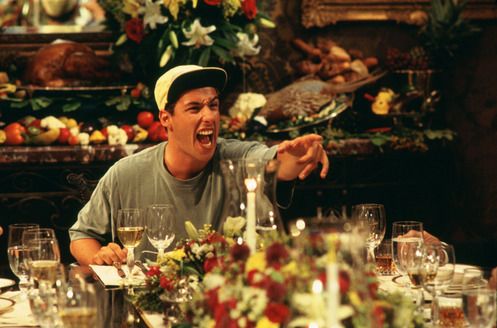 So, too, Americans
who were not brought up to act appropriately in a
restaurant never will. Not too long ago, people
would exit church on Sunday and have lunch at a
nice local restaurant wearing their Sunday best.
Parents would choose the outfit their children
would wear for a meal out, which was always a
special time. The idea of a grown man wearing a
baseball cap in a restaurant would have been
shocking—a trend that began when California casual
chic turned into Adam Sandler slovenliness.
So, too, Americans
who were not brought up to act appropriately in a
restaurant never will. Not too long ago, people
would exit church on Sunday and have lunch at a
nice local restaurant wearing their Sunday best.
Parents would choose the outfit their children
would wear for a meal out, which was always a
special time. The idea of a grown man wearing a
baseball cap in a restaurant would have been
shocking—a trend that began when California casual
chic turned into Adam Sandler slovenliness.
Children were also taught basic manners at
the table, to say “please” and “thank you” to
service staff, where to place their napkin when
leaving the table, which fork to use for seafood:
Little things, really, that don’t make the food
taste better but make the whole experience far
more appealing and comfortable for everybody.
Way
too many Americans become terrified at the
prospect of de-boning their own fish, sipping the
wine when first poured, consulting a sommelier or
even making a cordial complaint about a dish or
service out of fear of being wrong. 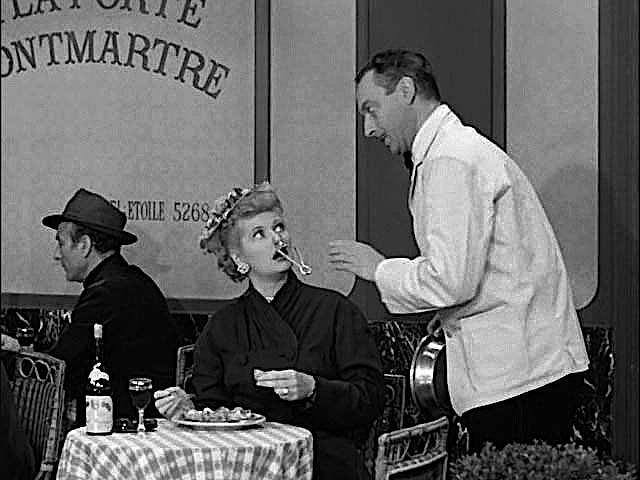 And, if one is so easily
intimidated by such small things, of course, one
will feel uncomfortable and blame it on the
restaurant as being “too fussy,” when it is not so
at all.
And, if one is so easily
intimidated by such small things, of course, one
will feel uncomfortable and blame it on the
restaurant as being “too fussy,” when it is not so
at all.
Too many Americans—male and female—also
believe that speaking very, very loudly in some
way makes them more interesting. In ultra-loud
restaurants such braying adds and builds on the
in-house noise. I swear that if the same exact
restaurant in America with a cacophonous decibel
level were transported to anywhere in France,
Spain, Italy or Belgium, the decibel level would
be half as high because European people do not
scream in the dining room.
There’s no doubt that the
restrictions on going out during Covid and the
consequent decrease in people dining at an upscale
restaurant have loosened everyone up, just as many
insist they will never surrender their sweatpants
for slacks to go back to the office. Suit
yourself, but by allowing yourself to feel awkward
you do yourself no favors and are missing some
wonderful meals in fine restaurants.
❖❖❖
The Acclaimed Eleven
Madison Park Restaurant Is Going Vegan.
But $335 Is A Lot Of Lettuce—For Lettuce
By John Mariani
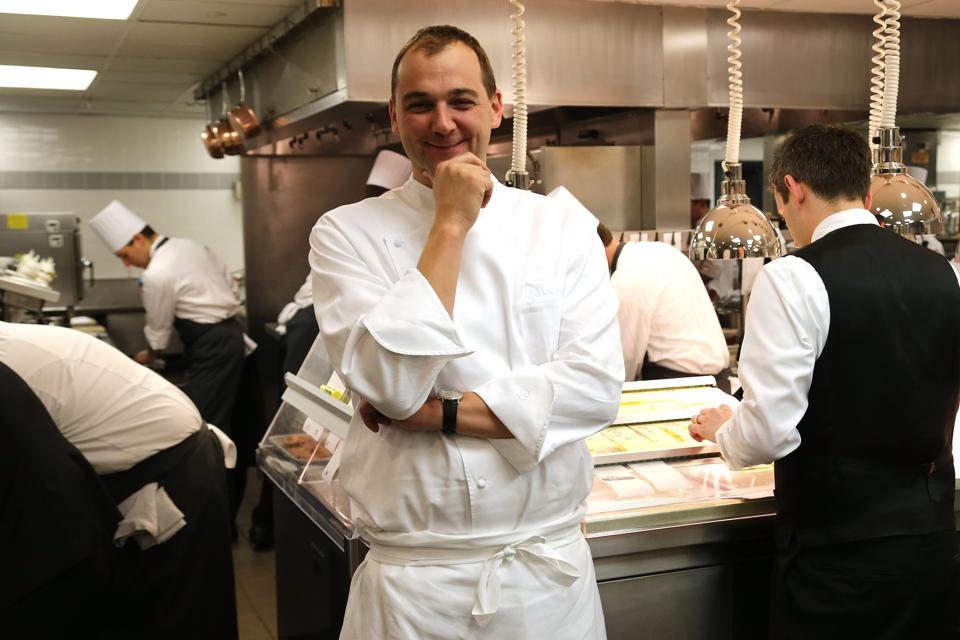
A few years
ago Daniel Humm, chef-owner of the much praised
New York restaurant Eleven Madison Park, had his
waitstaff perform card tricks at the table, a
frivolity that was soon abandoned after
criticism that it was a bit twee, if not
downright silly. Now he has announced that upon
re-opening the restaurant the menu will be
99.99% vegan, the exception being honey and milk
for tea and coffee. Bees, you see, make honey.
The price won’t change: $335 (including tip
but without drinks or wine), which in the past got
you an 11-course meal that included dishes like
dry-aged veal with bone marrow; a soft egg with
farro, corn and frogs’ legs; suckling pig with
blackberries; and a New England clambake dumped on
a brown paper mat. Now, though Humm has not
released his new vegan menu, all those dishes will
be banished.
 "The current food system is simply not
sustainable, in so many ways,” Humm told The New York
Times,
an extreme generalization for a chef who all his
working life purchased the finest meats, seafood
and dairy products available from sustainable
farms. “I wanted everyone who comes into contact
with Eleven Madison Park to become a part of doing
good,” Humm said, which is a real slap in the face
of anyone who might dare eat a burger or butter
their bread.
"The current food system is simply not
sustainable, in so many ways,” Humm told The New York
Times,
an extreme generalization for a chef who all his
working life purchased the finest meats, seafood
and dairy products available from sustainable
farms. “I wanted everyone who comes into contact
with Eleven Madison Park to become a part of doing
good,” Humm said, which is a real slap in the face
of anyone who might dare eat a burger or butter
their bread.
Eleven Madison Park has shape-shifted often
since it was originally opened by restaurateur
Danny Meyer in 1998 and sold to Humm and a partner
(with whom he later split) in 2006, and, owing to
his tremendous talent and creativity, managed to
wow the critics—the restaurant has three Michelin
stars and four from the Times—and
a public willing to pay top dollar for a four-hour
meal of the most sumptuous luxury backed by an
extraordinary wine list. So odds are being taken
on whether going total vegan—not just
vegetarian—will actually draw enough people who
once would have paid $335 for foie gras and caviar
but who might wince at that price for peas and
carrots.
Humm is betting on a trend many chefs have
picked up on by offering alternative vegetarian
menus alongside 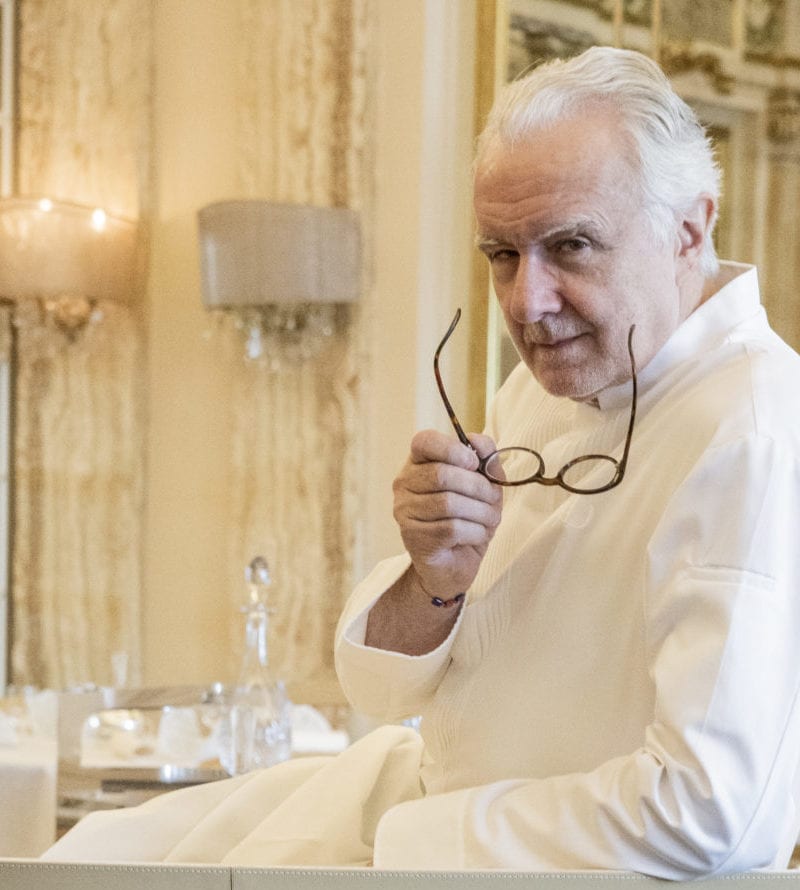 their
meat and seafood menu, which makes capital sense,
whether it’s Alain Ducasse at the Plaza-Athenée
and Alain Passard at L’Arpège in Paris or Massimo
Bottura at Osteria Francescana in Modena, Italy.
But few have attempted to go total vegan.
their
meat and seafood menu, which makes capital sense,
whether it’s Alain Ducasse at the Plaza-Athenée
and Alain Passard at L’Arpège in Paris or Massimo
Bottura at Osteria Francescana in Modena, Italy.
But few have attempted to go total vegan.
At the very least Humm’s commitment is
based on some tricky dynamics. For starters, why
serve honey and milk for tea and coffee when there
are perfectly decent non-animal substitutes? Also,
many vehement vegans believe that wine is anathema
because many wines are filtered through skins
containing animal products and others with egg
white, which sinks impurities to the bottom of the
barrels. How does he justify a wine list of such
dimensions as he now has when it’s impossible to
know which wines have been thus treated? And since
so many vegetables, 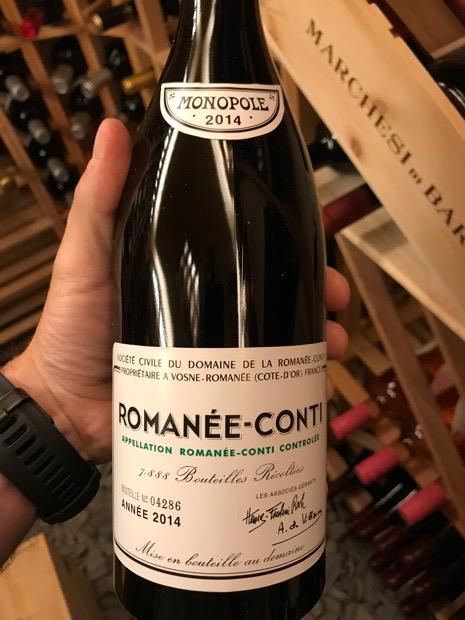 like
asparagus and artichokes, are notoriously
difficult to match with wines, it becomes a big
question whether anyone is going to pop for a
$5,000 red Burgundy that will go with anything on
the menu. Is any wine lover going to order a $500
oak-rich, high tannin California Cabernet with a
dish of arugula and rutabagas? And, since it is
very much a vegan proclivity to shed leather shoes
and accessories, will Humm and his staff follow
suit?
like
asparagus and artichokes, are notoriously
difficult to match with wines, it becomes a big
question whether anyone is going to pop for a
$5,000 red Burgundy that will go with anything on
the menu. Is any wine lover going to order a $500
oak-rich, high tannin California Cabernet with a
dish of arugula and rutabagas? And, since it is
very much a vegan proclivity to shed leather shoes
and accessories, will Humm and his staff follow
suit?
Business-wise, one has to wonder if a
company executive is going to invite a big
out-of-town client to a vegan restaurant, unless
everyone at the table is vegan. I’m sure there are
many who would happily enjoy the adventure of such
a meal, but the number of eager vegans is not
close to the number of vegetarians, who may eat
some seafood or have no problem with cheese-rich
lasagna. 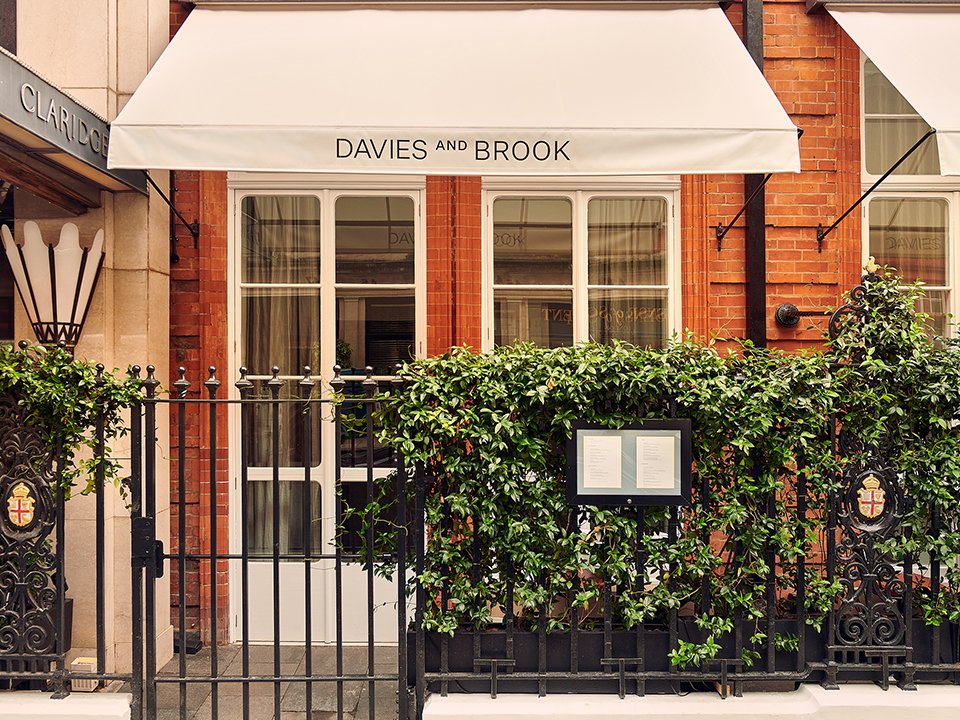
Humm
is not being so sanctimonious as to accuse those
who continue to eat hamburgers of having moral
failings; in fact, he is being remarkably
disingenuous, because, at his London restaurant
Davies and Brook, he continues to serve a chicken
burger with truffled mayo and cheddar cheese, a
seafood plateau of shellfish, and a dry-aged
ribeye steak. I don’t doubt his commitment but I
wonder if he has hopped on an extremist bandwagon,
and, as bandwagons like la nouvelle cuisine, the
Mediterranean Diet and molecular cuisine have
passed on by, I wonder if Eleven Madison Park will
become a significant beacon or a snapshot of the
current era, when Americans are being made to feel
guilty about taking pleasure in all kinds of food.
Or as Chris Rock once put it, “People are starving
all over the world. What do you mean, ‘red meat
will kill you?’ Don't eat no red meat? No, don't
eat no green
meat. If you lucky enough to get your hands on
a steak, bite the shit out of it!”
CAPONE’S
GOLD
Sunday
after
Mass, Katie got to David’s on the dot of one
and could tell he was cooking from the aroma
of onions and garlic coming from the kitchen
exhaust fan.
She poked her head in the open door and
said, “Hello? Am I on time?”
“Right on the nose,” said David. “Hope
you’re hungry.
How was Mass?”
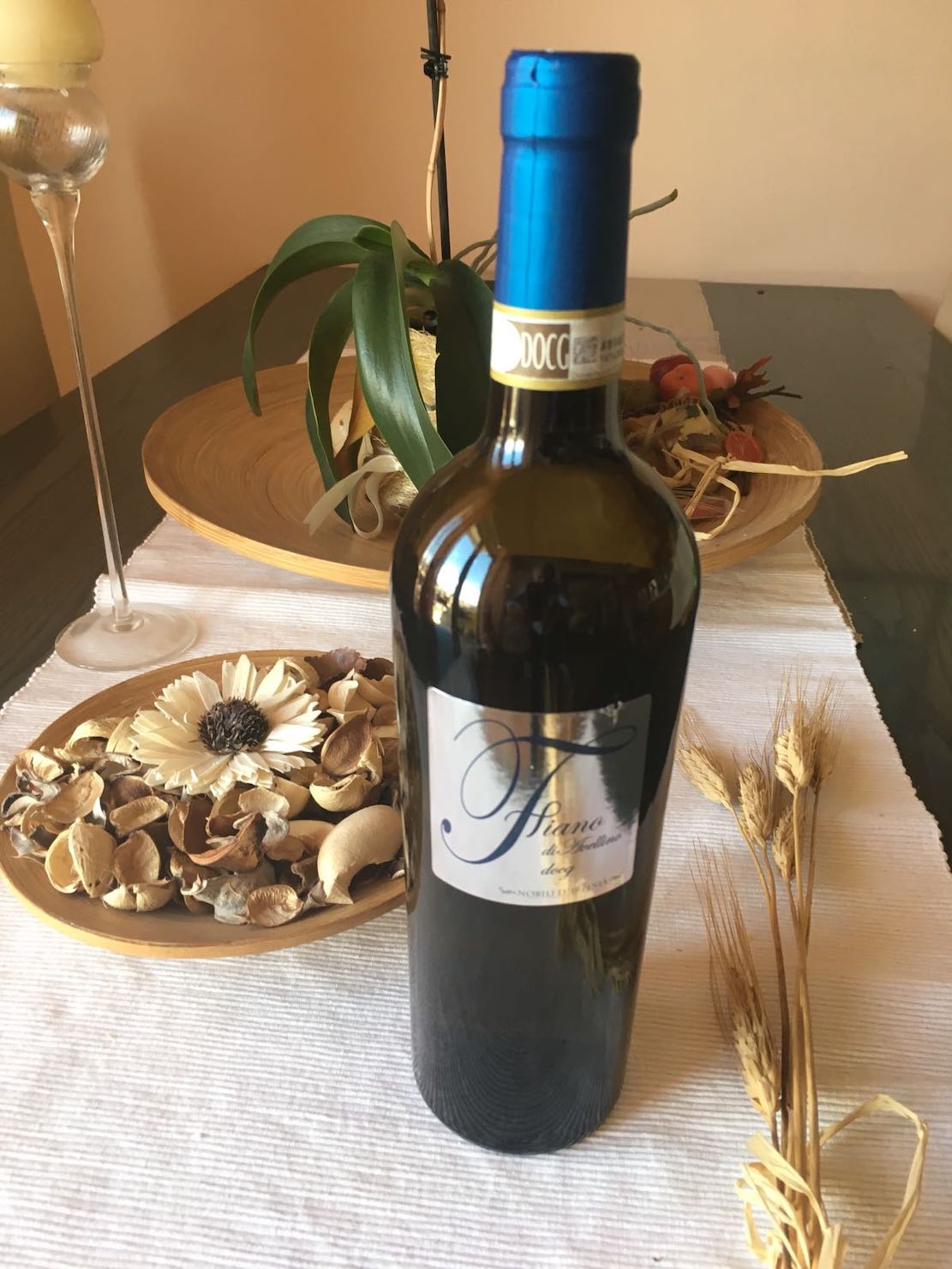 “It
was nice. I
found a rustic little church nearby the motel,
very quaint, good sermon, nice attendance.” She
wasn’t expecting David to say anything like, “I
should get back some time.”
“It
was nice. I
found a rustic little church nearby the motel,
very quaint, good sermon, nice attendance.” She
wasn’t expecting David to say anything like, “I
should get back some time.”
“Sit down, sit down. Some wine?”
“Sure.”
“White wine, okay?” David opened a bottle
of Fiano di Avellino and poured some into her
glass. “This wine comes from outside of Naples. I
thought it appropriate since Big Al’s family
came from that region. Salut’!”
“Mmm, it’s delicious. So
you’re a wine connoisseur?”
“Not really, but now that I’m retired I
drink it every day, a glass at lunch, the rest
of the bottle with dinner.”
“All by yourself?”
“Sometimes a friend comes by and helps
me.”
Katie didn’t—yet—think it right to ask if
the friend was a 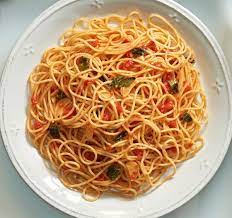 man or
woman.
man or
woman.
He’d been sautéing onions and garlic with
a little red pepper and added some crushed
tomatoes. Then
he tossed some spaghettini into a pot of boiling
salted water. “This cooks in like five minutes,”
he said. “Can you grab some plates from that
counter? There
are forks in the vase on the counter.”
Lunch was ready and Katie was again
impressed with David Greco’s handiwork as a
cook. “It’s
really delicious," she said. "Simple, quick,
very Italian. Y’know, I’ve sometimes wondered if
guys like Capone ever cooked anything
themselves.”
David said, “They
were all mama’s boys, y’know, and nobody could
cook like their mother!”
“Also very Italian,” said Katie, twirling
the al dente spaghetti. “My father’s the same
way. But you learned to cook?”
 David
just nodded, not telling her something.
David
just nodded, not telling her something.
For the rest of the lunch they just
chatted, getting to know each other a little
better to see if this joint project was going to
work out. Katie told him where she’d grown up,
what her parents and sister did, and how she got
into journalism.
“I
knew
your father when he was a D.A., then as a
judge,” said David. “First-rate
at both. He
worked mostly in the Bronx, of course—put a lot
of bad guys away—so our paths didn’t cross too
much because I was working more in Brooklyn and
Manhattan.
I would’ve liked to have a few more guys
like your father where I worked. He
must be a pretty heroic guy to you.”
“He was and is,” said Katie. “What about
you? You have any heroes?”
“Aside from the obvious, a guy like Frank
Serpico (above), who they made a movie
about. Pacino
again. Also a bad cop turned good cop to catch
the bad cops, name’s Robert Leuci (below)—another
Italian. He
started out 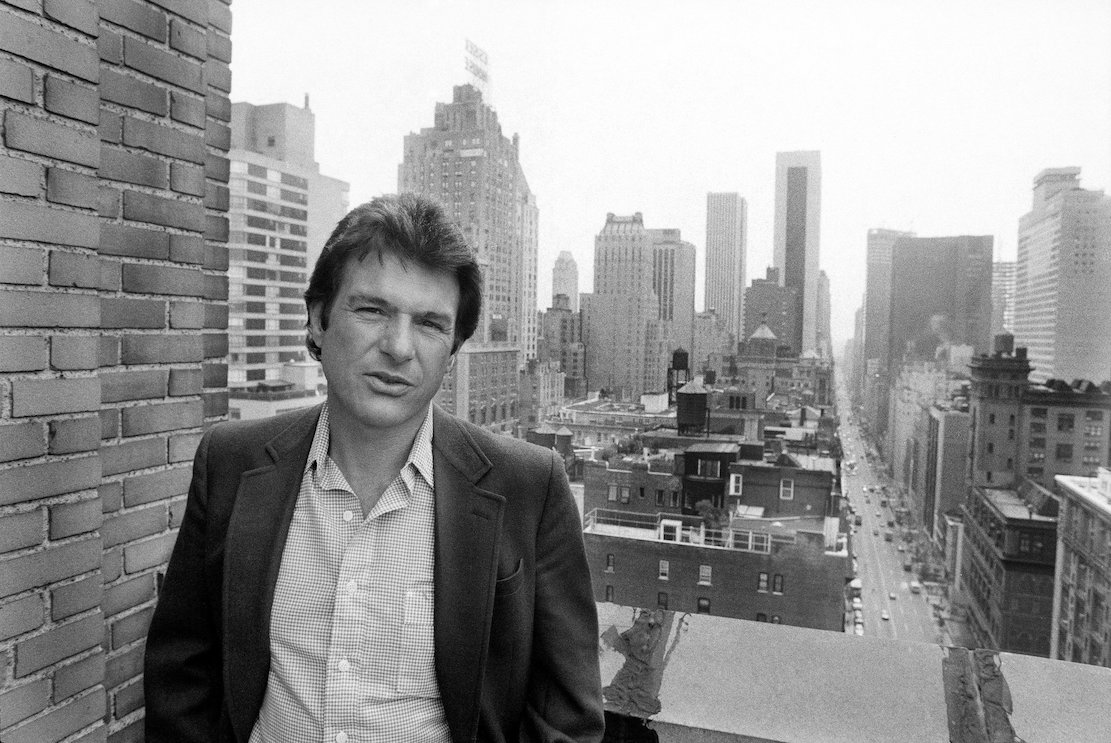 taking
graft, then volunteered to root out the bad cops
in narcotics, who were not only taking bribes
but selling the stuff themselves. I
remember that of seventy guys who worked in the
Narcotics Division back in the late ’60s,
fifty-two of them were indicted because of
Leuci’s going undercover and exposing them. One of
them was his former partner.”
taking
graft, then volunteered to root out the bad cops
in narcotics, who were not only taking bribes
but selling the stuff themselves. I
remember that of seventy guys who worked in the
Narcotics Division back in the late ’60s,
fifty-two of them were indicted because of
Leuci’s going undercover and exposing them. One of
them was his former partner.”
“Sounds like a brave guy,” said Katie,
lifting her glass of wine in tribute.
“Tough as nails, fearless, but supposed
to be really charming. He
once talked his way out of getting murdered
after they found a wire on him. Made a movie
about him, too: Prince of the City.”
“What happened to him?”
“He’s still alive,” said David. “For a
while he was in the Witness Protection Program. There
were a lot of cops who would have killed him on
sight. He
and I were in different units of NYPD, but if I
had a guy like Leuci with me, my job would have
been easier, especially towards the end.”
“Why’s that?” asked Katie, sipping her
wine.
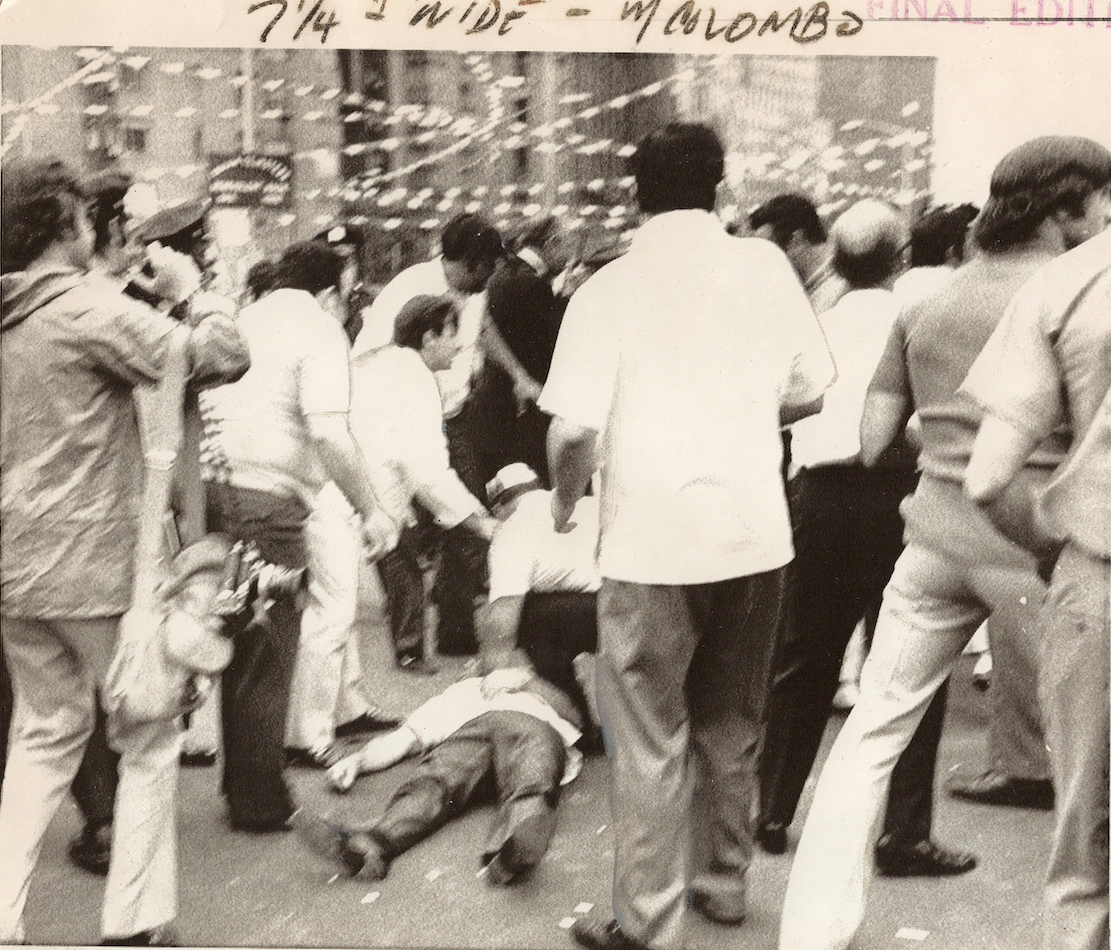 “Well, as I might have told you, I was
recruited by Giuliani when he was D.A., and he
was very determined to destroy the mobs,
especially the Italians, the so-called `Five
Families’ that started back in the 1930s. He
wanted to wipe out that association of Italians
as all being gangsters or of even knowing
gangsters. I didn’t know any wise guys while I
was growing up, did you?”
“Well, as I might have told you, I was
recruited by Giuliani when he was D.A., and he
was very determined to destroy the mobs,
especially the Italians, the so-called `Five
Families’ that started back in the 1930s. He
wanted to wipe out that association of Italians
as all being gangsters or of even knowing
gangsters. I didn’t know any wise guys while I
was growing up, did you?”
Katie shook her head and said, “Nope,
except for the ones my father spoke about.”
David continued. “By
the time I arrived on the scene, the crime
syndicates’ territories were pretty much carved
up: the Bonanno family had the most range,
mostly Brooklyn and Queens but out to Long
Island, the Bronx, and up to Westchester. The
Colombos were also in Brooklyn and Queens, with
tentacles in New Jersey and Florida. The
Gambinos had a bit more presence in Manhattan,
along with Brooklyn and Staten Island, but they
even established a branch in L.A. The
Genoveses were most powerful in Manhattan but
pushed up into Rockland County and New 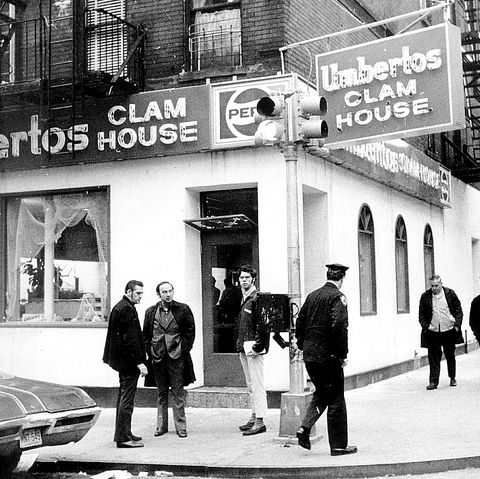 England.
The Luccheses were in all the boroughs.
England.
The Luccheses were in all the boroughs.
“They all had their turf and they were
always in dispute with each other over
expansion.
That’s when you saw the very public
murders of
`Crazy’ Joey Gallo at Umberto’s Clam
House, Joe Colombo at a public rally in Columbus
Circle (above), and Paul Castellano
outside Spark’s Steakhouse in midtown.
“The
capos were constantly shifting allegiances. All
that honor among thieves and taking oaths—it was
all a bunch of bullshit. Those
guys would kill anyone who got in their way. Joe
Valachi once told a Senate Committee that if you
went to Vito Genovese and told him some guy was
doing wrong within his mob, Genovese would have
the guy killed, then he killed you for ratting
out the guy.”
Katie was fascinated by David’s recall of
who ruled what and where and who killed whom. “Did
any of these guys come out of the Capone gang?”
“A few, not many. Remember,
Capone was not Sicilian, and most of these other
guys were.
I’m not sure about Genovese. I think he
came from Naples.”
“So what happened with you and Giuliani?”
“Let me put it this way: when Rudy became
mayor, he was like Fiorello LaGuardia in his
first term, everybody loved him—except the
mob—in his second term he’d gained so much ego
he turned into Benito Mussolini. Went
bald and even started to look like him. He was
tough during both terms, but, like someone once
said about a zealot, ‘He redoubled his efforts
after losing sight of his original goal.’”
“That’s good.”
David went on. “Rudy came down hard on
the mob and he finally got Gotti, who was a real
thorn in his side, but in his second term he was
more concerned about reducing street crime while
the mobs were still festering. He
says he reduced crime significantly—and it did
drop, but it was dropping in every big city by
the beginning of the ‘90s. Like I
said, he got to be like Mussolini, bragging
about minor achievements and thinking the
Presidency of the United States was fucking owed
to him. ‘Scuse
my French. Anyway, it’s a long story. I was
there for the best of it, but I got out when I
saw I was no longer an effective part of it.”
 Katie said, “You sound . . .
conflicted.”
Katie said, “You sound . . .
conflicted.”
David winced. “That doesn’t actually
sound much like me. Pissed off, maybe. Disappointed. Not
conflicted.
I did what I was trained to do until I
couldn’t do it the way it should have been done.
You get to know when a case is closed and the
doors are shut in your face. More
wine?”
Katie blinked her eyes and said, “Not if
we’re going to get any work done today. It’s
already two-thirty.”
“Guess
you’re right. Let me clear these dishes away.”
“No, I got ‘em,” Katie said, grabbing the
plates and silverware.
“Leave the wineglasses,” said David. “We
may get thirsty.”
“You tell me your process first,” said
David.
“Ah, well, I’ve never done any crime
investigation stories—that’s why I’m here with
you—but I usually begin by reading everything I
can on the subject, go back to old newspapers
and magazines for clippings, then start making
calls to the subject under scrutiny and his or
her friends and people who have worked with him
or her. Then I check stories against others’
versions.”
“Okay,” said David, “I do some of that,
but I spend a lot more time on the street,
talking to sources and cultivating new ones.
Every cop knows a guy who owes him a favor and
vice-versa.
If you’re lucky, you get an undercover
cop to infiltrate, but that can be very
dangerous.
Plus the mob hates that! Wiretaps
are a cop’s best friend, but you need a warrant
for those.”
 “Are they easy to
get?” asked Katie.
“Are they easy to
get?” asked Katie.
“Usually, unless the judge hates your
guts or is being paid off. There’s
always another judge you can go to.”
“And can you trust your sources?”
“Well, I suspect that’s one big
difference between yours and mine. If
you’re doing a story on, I don’t know, a movie
star or a politician, people fall over
themselves to talk, even if they’re making it
up. My sources invariably lie through their
teeth or give as little information as possible. You
get to know when the information is true by
comparing it to other guys’ stories, which may
also be full of lies.”
“Excuse me for asking, but, uh, is it
like in the movies where the cops beat a
confession out of a guy?”
David squinted at her. “If
you’re asking did I ever beat it out of
a guy, the answer is no. The
main reason is because there’s a good chance
nothing you get will hold up in court. If
you’re asking me if some cops make it rough on a
guy, the answer is yes, not by physically
beating them but by psychologically intimidating
and threatening them, so, more often than you’d
like to believe a lot of guys cop a plea in the
station house or even plead guilty to something
they didn’t do.”
Katie shook her
head. “What about the Miranda Rights thing?”
David laughed. “Ha, some of these guys
recite it right along with you, some of the time
they even sing it.
Even so, before the guy’s lawyer arrives
or is appointed, a good cop—you know, ‘good
cop’-‘bad cop’—can get a lead out of a suspect. Anyway,
with the mob guys, they knew Miranda cold and
wouldn’t talk unless they were in deep shit and
could get out of it only by ratting out the
higher-ups.
That’s the only way we got Gotti in the
end. Believe
me, a lot of murderers walk because they are
willing to talk.”
“It would have been different in Capone’s
day?” Katie asked.
“The penalties for ratting on a boss were
probably the same back then, and I have no idea
what the cops or the feds could offer a guy to
turn state’s evidence. They
didn’t have the Witness Protection Program back
then. In any case, no one ever ratted on
Capone.”
They returned to the files for the next
few hours, then Katie noted the lateness of the
hour and said, “Well, David, you’ve seen just
about all I’ve got on paper and up here”—tapping
her temple—“but I’m not sure how to proceed. I have
some names and numbers to call. And I
thought I’d go to Chicago to do some more
research and snoop around.”
“Snoop around? Let’s leave the snooping
around to me for the time being. It’s
fine to go to Chicago, check the archives, look
at the places things happened back then. Good
for background and what do they call
it—‘color’—for your story. And while you’re out
there I’ll start snooping around here with some
of my older colleagues who might have some leads
on Capone.
Tell you what, I’ll call a cop I know in
Chicago to kind of smooth the way, if you need
assistance.”
“That would be great,” said Katie. “I’ll
leave in a day or two and report back to you by
phone.”
David shrugged. “Suit yourself. Expect me
to keep things close to my vest at the
beginning. I don’t like to speculate too much
unless I have something solid to go on.”
“Fair enough,” said Katie. “So, thanks
for lunch and the wine. I owe you one.”
“Let me know if you find any good
restaurants in Chicago.”
“Happy to, if I have the time to find
them. I
wonder if any of Capone’s old restaurants still
exist?”
“I doubt it. But
have fun.”
David
was
sorry to see Katie leave. Nice
girl, good head on her shoulders. She’s going to
write a good story.
© John Mariani, 2015
NOTES FROM THE WINE CELLAR
The 2016 Vintage
By John Mariani
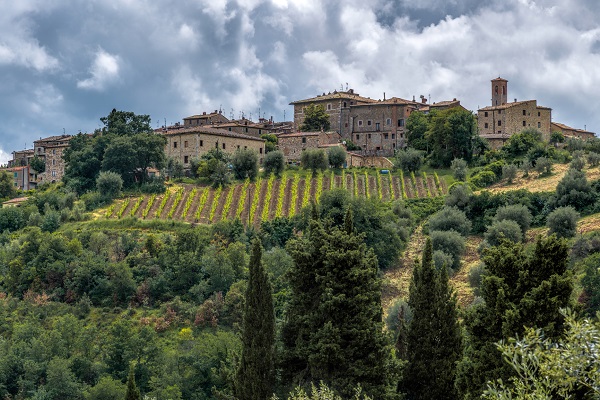
Montalcino
A few weeks ago I wrote that
Italian wine laws, which began in 1966 to make
sense of all the grapes and regions of the
country, had become so suspiciously generous in
awarding the highest appellation of DOCG (denominazione
di
origine controllata garantita),
guaranteeing the wine in the bottle was among
the finest in its region, that it has become
almost meaningless as a guide. I noted that DOCG
started out with only five wines, among which
was Tuscany’s Brunello di Montalcino, at a time
when there were only a handful of producers
making it according to a 100-year-old tradition
of viniculture. Yet, today there are more than
200 producers in Tuscany pumping out Brunello.
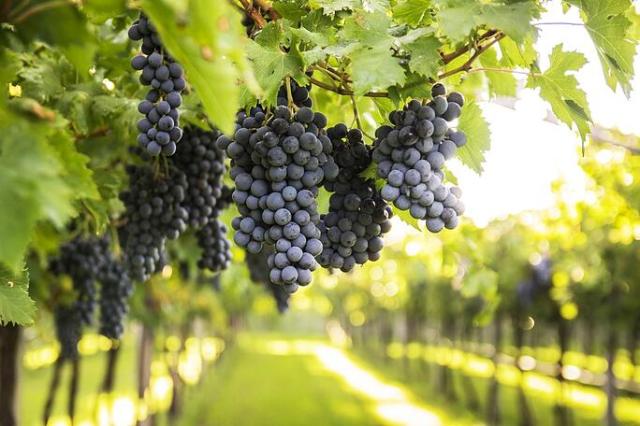 While that
creates considerable doubt as to how many of them
could be guaranteed superior wines, it is worth
taking a look at what some of the best are doing
with this wine long known for its ability to age
50 years or more in the bottle. Indeed, back in
1976 at the estate of Biondi-Santi, whose
progenitor created the Brunello using 100%
Sangiovese grapes, I tasted an example that was a
75 years old, and I was amazed by its excellence
and freshness.
The same cannot be said for most of today’s
Brunellos—and I’m not going to live long enough to
find out—but, as in everything, not least the
global wine world, Brunellos have evolved, and the
best of them do indeed deserve their DOCG and
recognition as among the finest wines of the
world.
While that
creates considerable doubt as to how many of them
could be guaranteed superior wines, it is worth
taking a look at what some of the best are doing
with this wine long known for its ability to age
50 years or more in the bottle. Indeed, back in
1976 at the estate of Biondi-Santi, whose
progenitor created the Brunello using 100%
Sangiovese grapes, I tasted an example that was a
75 years old, and I was amazed by its excellence
and freshness.
The same cannot be said for most of today’s
Brunellos—and I’m not going to live long enough to
find out—but, as in everything, not least the
global wine world, Brunellos have evolved, and the
best of them do indeed deserve their DOCG and
recognition as among the finest wines of the
world.
The 2016
vintage, though only four years old and just
released this year, is a good starting point with
which to examine the array of Brunellos out there,
some of which are now reaching alcohol levels
rarely seen but increasingly problematic as global
warming affects the vineyards and grapes. Corte
Pavone at 15% is edging into the zone of no
return, I’m afraid, and too many from 2016 are
already at 14.5%.
The basics of Brunello are as follows: It
is made from the Sangiovese grape, which is not at
all a rarity and not exclusive to Tuscany, but
that’s where it grows best. It has other names:
Morellino, Prugnolo, Nielluccio and, in Algeria,
Toustain. Sangiovese Grosso is the clone used for
Brunello, though decades ago few Tuscan vineyard
owners knew exactly what they were planting or
harvesting. 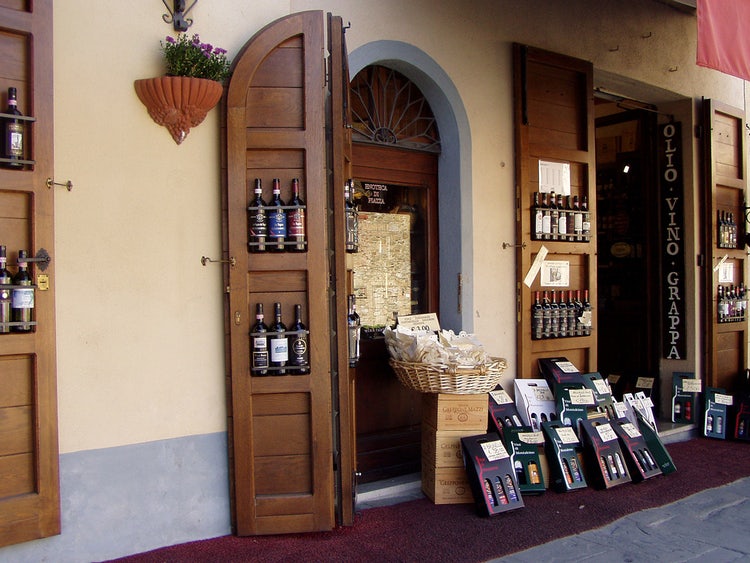
At the beginning of the 19th century
Sangiovese Grosso (also called Sangioveto and once
called Brunello) was pretty much limited to
Tuscany and Romagna, and not all over Tuscany in
any case. Today there are 102 different clones
registered in the Italian National Registry. When
Biondi-Santi began producing Brunellos, the
tannins took a long while to release their grip,
but, after a decade or more, the wines came into a
magnificent, elegant harmony of fruit, acid and
tannins.
The 1997
vintage, which was declared a “vintage of the
century,” went through a dumb period after about
ten years in the bottle, but finally emerged as a
bold, 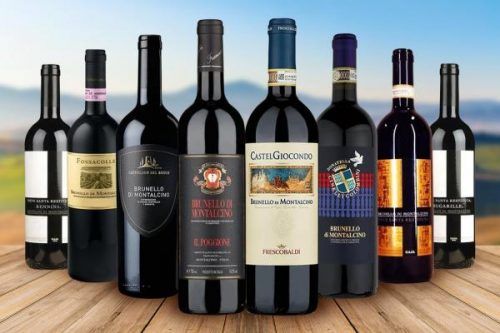 sumptuous wine
in the old style. Wines from 2001 can still take
more age, while 2004 is a classic; 2006 was fruit
forward and now more than ready to drink, while
2010 promises a long life. Current rules decree
that Brunellos must age in barrel for two years
and at least four months in bottle, which is quite
a short minimum. Still, they are not released
until four years after harvest, and riservas
five.
sumptuous wine
in the old style. Wines from 2001 can still take
more age, while 2004 is a classic; 2006 was fruit
forward and now more than ready to drink, while
2010 promises a long life. Current rules decree
that Brunellos must age in barrel for two years
and at least four months in bottle, which is quite
a short minimum. Still, they are not released
until four years after harvest, and riservas
five.
The 2016 has great vivacity even now, and
there were a few I recently sampled that I wished
I’d waited a while to taste. Brunellos made around
and north of the town of Montalcino, where it is
warm but dry, tend to be a bit lighter, while
fleshier examples come from south and southeast of
the town.
In 2008 a scandal broke, which the press  called “Brunellopoli,” in which
the government accused several major producers of
adulterating their wines with foreign and domestic
varieties. U.S. importers blocked any Brunellos
without an approved “100% Sangiovese” label. In
the end not much happened but a rap on the hand.
But it brought into focus what many other
non-Brunello Tuscan producers had been doing with
pride: blending varietals like Cabernet Sauvignon
and Merlot to make a distinctive wine that did not
meet the standards of the DOCG appellation but
that nevertheless, as single-estate wines, did
very well in the market.
called “Brunellopoli,” in which
the government accused several major producers of
adulterating their wines with foreign and domestic
varieties. U.S. importers blocked any Brunellos
without an approved “100% Sangiovese” label. In
the end not much happened but a rap on the hand.
But it brought into focus what many other
non-Brunello Tuscan producers had been doing with
pride: blending varietals like Cabernet Sauvignon
and Merlot to make a distinctive wine that did not
meet the standards of the DOCG appellation but
that nevertheless, as single-estate wines, did
very well in the market.
What to look for in Brunello for 2016?
There are some always dependable, often
prestigious names, including Biondi-Santi,
Barbi-Colombini, Il Poggione, Vostanti, Col
d’Orcia, Lisini, and Mastrojanni. Of newer
producers I like Val di Suga, whose first vintage
was in 1977, it has 14.5% alcohol but shows well
for its cherry fruit; Cava d’Onice is now
restrained but shows real promise five years from
now; Ridolfi is a pleasure right now. Some have
not yet been shipped to the U.S., and the riservas
will not be here until next year.
Right now there
is so much discounting going on in wine stores
that a wine that may be listed at $60 may now be
found for $45, and there are plenty of Brunellos
selling in the $35 range, which is the price of a
fine Chianti Classico.
❖❖❖

ARTICLES WE NEVER
STARTED READING
“How I Ate My Way Through 14 Days in a Korean
Quarantine Facility,” By James Park, Eater.com
(4/29/21)
❖❖❖
Sponsored by

Any of John Mariani's books below may be ordered from amazon.com.
 The Hound in Heaven
(21st Century Lion Books) is a novella, and
for anyone who loves dogs, Christmas, romance,
inspiration, even the supernatural, I hope you'll find
this to be a treasured favorite. The story
concerns how, after a New England teacher, his wife and
their two daughters adopt a stray puppy found in their
barn in northern Maine, their lives seem full of promise.
But when tragedy strikes, their wonderful dog Lazarus and
the spirit of Christmas are the only things that may bring
his master back from the edge of despair.
The Hound in Heaven
(21st Century Lion Books) is a novella, and
for anyone who loves dogs, Christmas, romance,
inspiration, even the supernatural, I hope you'll find
this to be a treasured favorite. The story
concerns how, after a New England teacher, his wife and
their two daughters adopt a stray puppy found in their
barn in northern Maine, their lives seem full of promise.
But when tragedy strikes, their wonderful dog Lazarus and
the spirit of Christmas are the only things that may bring
his master back from the edge of despair. WATCH THE VIDEO!
“What a huge surprise turn this story took! I was completely stunned! I truly enjoyed this book and its message.” – Actress Ali MacGraw
“He had me at Page One. The amount of heart, human insight, soul searching, and deft literary strength that John Mariani pours into this airtight novella is vertigo-inducing. Perhaps ‘wow’ would be the best comment.” – James Dalessandro, author of Bohemian Heart and 1906.
“John Mariani’s Hound in Heaven starts with a well-painted portrayal of an American family, along with the requisite dog. A surprise event flips the action of the novel and captures us for a voyage leading to a hopeful and heart-warming message. A page turning, one sitting read, it’s the perfect antidote for the winter and promotion of holiday celebration.” – Ann Pearlman, author of The Christmas Cookie Club and A Gift for my Sister.
“John Mariani’s concise, achingly beautiful novella pulls a literary rabbit out of a hat – a mash-up of the cosmic and the intimate, the tragic and the heart-warming – a Christmas tale for all ages, and all faiths. Read it to your children, read it to yourself… but read it. Early and often. Highly recommended.” – Jay Bonansinga, New York Times bestselling author of Pinkerton’s War, The Sinking of The Eastland, and The Walking Dead: The Road To Woodbury.
“Amazing things happen when you open your heart to an animal. The Hound in Heaven delivers a powerful story of healing that is forged in the spiritual relationship between a man and his best friend. The book brings a message of hope that can enrich our images of family, love, and loss.” – Dr. Barbara Royal, author of The Royal Treatment.
 |
The Encyclopedia of American Food and Drink by John F. Mariani (Bloomsbury USA, $35) Modesty forbids me to praise my own new book, but let me proudly say that it is an extensive revision of the 4th edition that appeared more than a decade ago, before locavores, molecular cuisine, modernist cuisine, the Food Network and so much more, now included. Word origins have been completely updated, as have per capita consumption and production stats. Most important, for the first time since publication in the 1980s, the book includes more than 100 biographies of Americans who have changed the way we cook, eat and drink -- from Fannie Farmer and Julia Child to Robert Mondavi and Thomas Keller. "This book is amazing! It has entries for everything from `abalone' to `zwieback,' plus more than 500 recipes for classic American dishes and drinks."--Devra First, The Boston Globe. "Much needed in any kitchen library."--Bon Appetit. |
"Eating Italian will never be the same after reading John Mariani's entertaining and savory gastronomical history of the cuisine of Italy and how it won over appetites worldwide. . . . This book is such a tasteful narrative that it will literally make you hungry for Italian food and arouse your appetite for gastronomical history."--Don Oldenburg, USA Today. "Italian
restaurants--some good, some glitzy--far
outnumber their French rivals. Many of
these establishments are zestfully described
in How Italian Food Conquered the World, an
entertaining and fact-filled chronicle by
food-and-wine correspondent John F.
Mariani."--Aram Bakshian Jr., Wall Street
Journal.
"Equal parts
history, sociology, gastronomy, and just
plain fun, How Italian Food Conquered the
World tells the captivating and delicious
story of the (let's face it) everybody's
favorite cuisine with clarity, verve and
more than one surprise."--Colman Andrews,
editorial director of The Daily
Meal.com. "A fantastic and fascinating
read, covering everything from the influence
of Venice's spice trade to the impact of
Italian immigrants in America and the
evolution of alta cucina. This book will
serve as a terrific resource to anyone
interested in the real story of Italian
food."--Mary Ann Esposito, host of PBS-TV's
Ciao
Italia. "John Mariani has written the
definitive history of how Italians won their
way into our hearts, minds, and
stomachs. It's a story of pleasure over
pomp and taste over technique."--Danny Meyer,
owner of NYC restaurants Union Square
Cafe, The Modern, and Maialino.
|
 |
 |
 |
 |
 |
 |
 Everett Potter's Travel Report:
Everett Potter's Travel Report: 
 Eating Las
Vegas JOHN CURTAS has been covering
the Las Vegas food and restaurant scene
since 1995. He is the co-author of EATING LAS
VEGAS – The 50 Essential Restaurants (as
well as the author of the Eating Las
Vegas web site: www.eatinglasvegas.
He can also be seen every Friday morning as
the “resident foodie” for Wake Up With the
Wagners on KSNV TV (NBC) Channel 3 in
Las Vegas.
Eating Las
Vegas JOHN CURTAS has been covering
the Las Vegas food and restaurant scene
since 1995. He is the co-author of EATING LAS
VEGAS – The 50 Essential Restaurants (as
well as the author of the Eating Las
Vegas web site: www.eatinglasvegas.
He can also be seen every Friday morning as
the “resident foodie” for Wake Up With the
Wagners on KSNV TV (NBC) Channel 3 in
Las Vegas.
MARIANI'S VIRTUAL GOURMET
NEWSLETTER is published weekly. Publisher: John Mariani. Editor: Walter Bagley. Contributing Writers: Christopher Mariani,
Robert Mariani, Misha Mariani, John A. Curtas, Gerry Dawes, Geoff Kalish,
and Brian Freedman. Contributing
Photographer: Galina Dargery. Technical
Advisor: Gerry
McLoughlin.
If you wish to subscribe to this
newsletter, please click here: http://www.johnmariani.com/subscribe/index.html
© copyright John Mariani 2021
